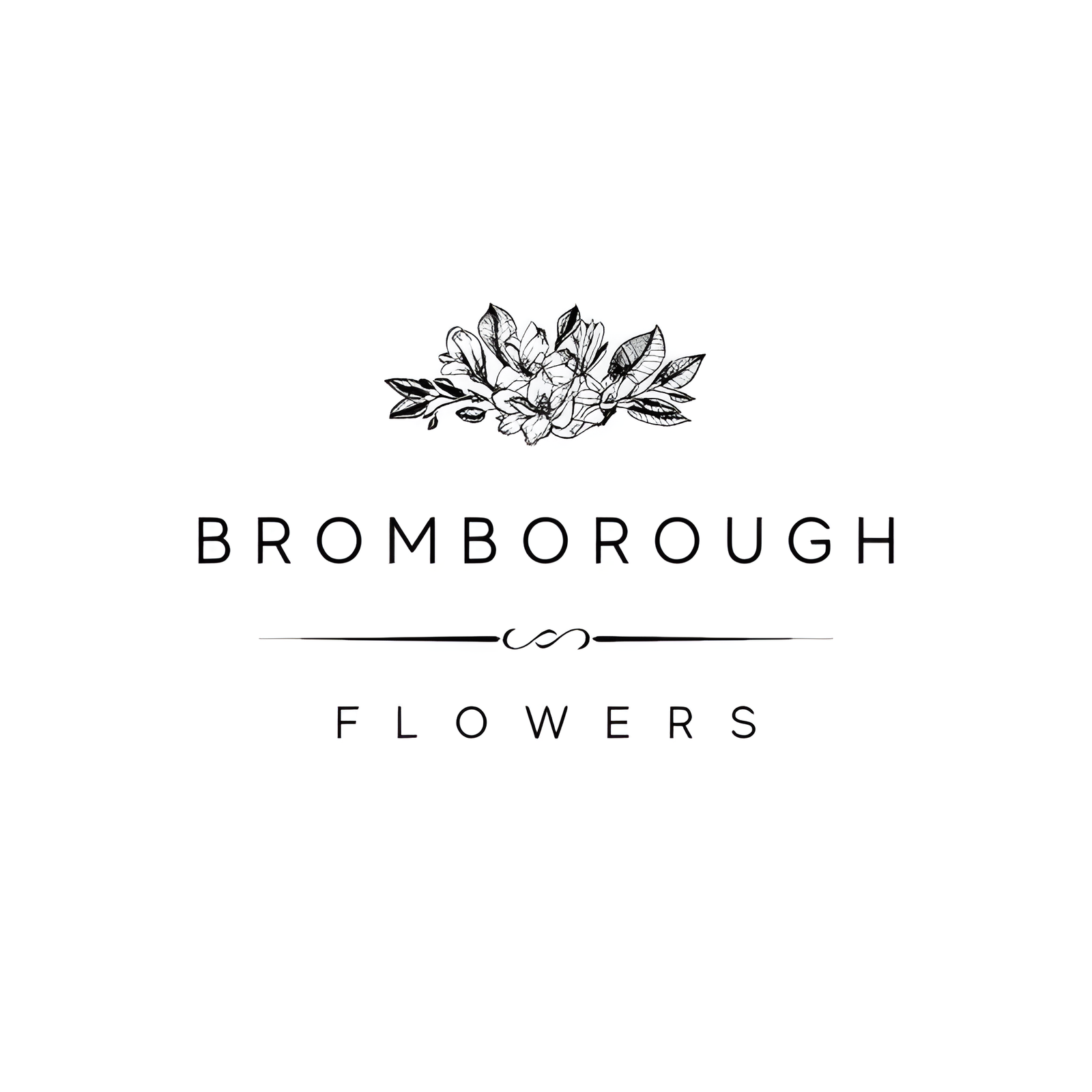Eryngium, or Sea Holly, offers a unique blend of elegance and resilience, making it a compelling choice for wedding floral arrangements. With its distinctive thistle-like structure and striking metallic hues, this member of the Apiaceae family is particularly well-suited for rustic or beach-themed weddings. Beyond its visual appeal, Eryngium symbolizes strength and tranquility, adding depth and meaning to bridal bouquets, boutonnieres, and centerpieces. As you explore the various dimensions of this extraordinary flower, from its physical characteristics to its cultural significance, you’ll uncover why Eryngium stands out in the world of wedding floristry.
Flower Overview
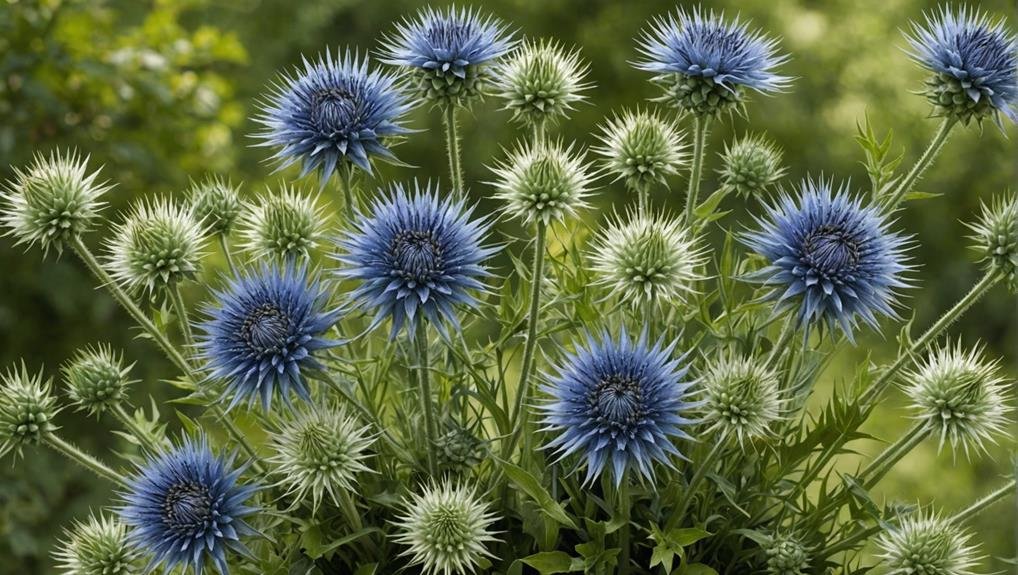
Eryngium, commonly known as Sea Holly, is a distinctive thistle-shaped flower renowned for its striking metallic hues and versatility in wedding arrangements. Originating from the Apiaceae family, Sea Holly is particularly popular in Scottish weddings due to its unique aesthetic appeal.
The flowers range in color from cobalt blue to deep purple, with some varieties, such as Eryngium Alpinum White Star, featuring nearly white blooms. This diversity in coloration allows for a broad spectrum of design possibilities, catering to various wedding themes and color schemes.
Sea Holly is frequently sold in wraps containing 10 to 25 stems, with stem lengths varying from 50 to 80 centimeters. This makes it convenient for florists to incorporate into bouquets, centerpieces, and other floral arrangements. The flower’s metallic sheen adds a touch of elegance and sophistication, enhancing the overall visual impact of the arrangement.
Additionally, its thistle-like structure lends a unique texture, making it a versatile choice for both traditional and contemporary wedding designs. Due to its robust nature and striking appearance, Sea Holly continues to be a favored option for couples seeking to add a distinctive and memorable touch to their special day.
Physical Description
Characterized by its spiky, thistle-like appearance, Sea Holly features a mesmerizing metallic blue or purple hue that makes it a standout in any floral arrangement. Belonging to the Apiaceae family, this unique flower captivates with its distinctive structure and coloration, often making it a sought-after choice for weddings and events.
Sea Holly’s physical attributes are both intriguing and elegant. The flowers consist of a lacy blue-purple calyx that surrounds globe-like blooms, enhancing their visual appeal. These globe-shaped flower heads add texture and interest to bouquets and arrangements, contributing to their popularity in floral designs.
Here are some key features of Sea Holly’s physical description:
- Thistle-Like Structure: The flower’s spiky, thistle-like shape distinguishes it from other blooms, adding a touch of wild beauty to any arrangement.
- Metallic Hue: Its metallic blue or purple colors create a striking visual effect, making it a focal point in bouquets.
- Lacy Calyx: The lacy calyx surrounding the bloom adds an intricate detail that enhances the flower’s overall elegance.
- Texture and Interest: The unique texture of the flower heads provides a rich, tactile element to floral designs, setting it apart from softer flowers.
Sea Holly’s striking physical characteristics make it an exceptional addition to any wedding flower arrangement.
Available Colour Varieties
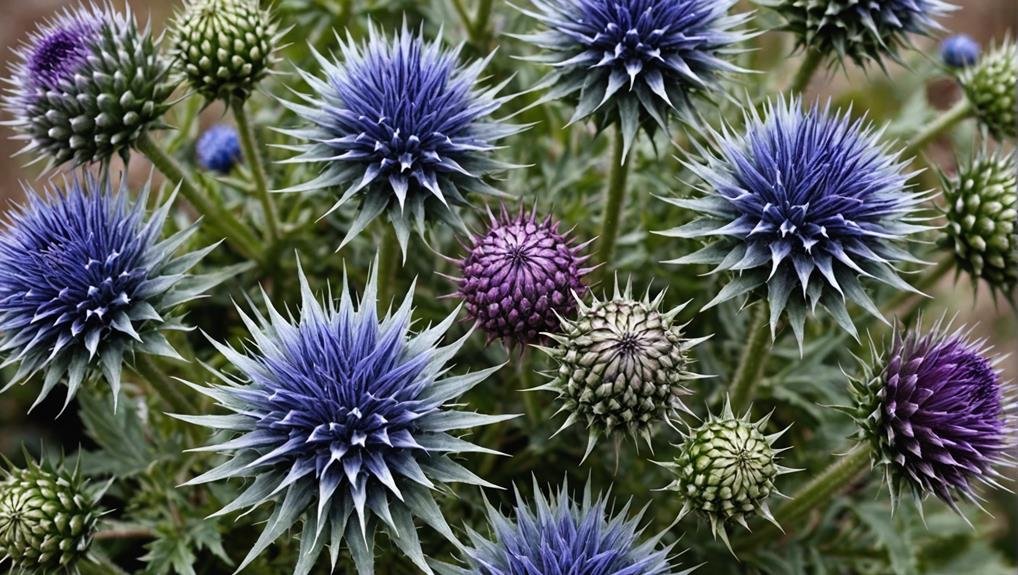
Among the enchanting features of Sea Holly, its wide range of available color varieties further enhances its appeal in wedding floral arrangements. This alluring flower, known for its thistle-shaped blooms, offers an array of hues that can complement various wedding themes and color palettes.
Sea Holly mainly showcases shades of blue, with varieties ranging from cobalt blue to deep purple. These intense blue tones, combined with the flower’s unique, globe-like appearance and metallic silver hues, make Sea Holly a striking addition to any bouquet or centerpiece. The distinct blue coloration adds a touch of elegance and sophistication, ideal for both modern and traditional wedding settings.
In addition to its classic blue shades, Sea Holly is also available in nearly white varieties, such as Eryngium Alpinum White Star. This particular variety provides an alternative for those seeking a softer, more understated look while maintaining the flower’s characteristic texture and shape. The nearly white blooms of Eryngium Alpinum White Star can blend seamlessly into more delicate and neutral color schemes, offering versatility for wedding designers.
Latin Name and Taxonomy
Within the Apiaceae family, Sea Holly is scientifically known by its Latin name, Eryngium. This genus encompasses various species, each exhibiting unique characteristics that make them a popular choice for wedding arrangements. The taxonomy of Eryngium classifies it under the order Apiales and the family Apiaceae, highlighting its close relationship with other well-known plants such as carrots and parsley. Eryngium stands out for its thistle-shaped flower heads and spiky foliage, a distinctive feature that adds a striking visual element to floral designs.
There are several remarkable species within the Eryngium genus:
- Eryngium alpinum: Known for its vibrant blue and purple hues, this species is commonly used in wedding bouquets.
- Eryngium planum: This variety features smaller, more rounded flower heads and is often favored for its delicate appearance.
- Eryngium maritimum: Also known as Sea Holly, this coastal species boasts silvery-blue leaves and is a favorite for beach-themed weddings.
- Eryngium giganteum: Nicknamed ‘Miss Willmott’s Ghost,’ this species is renowned for its striking silvery-white bracts and tall stature.
Understanding the taxonomy of Sea Holly not only enhances appreciation for its botanical uniqueness but also aids in selecting the most suitable species for specific floral arrangements.
Geographical Origins
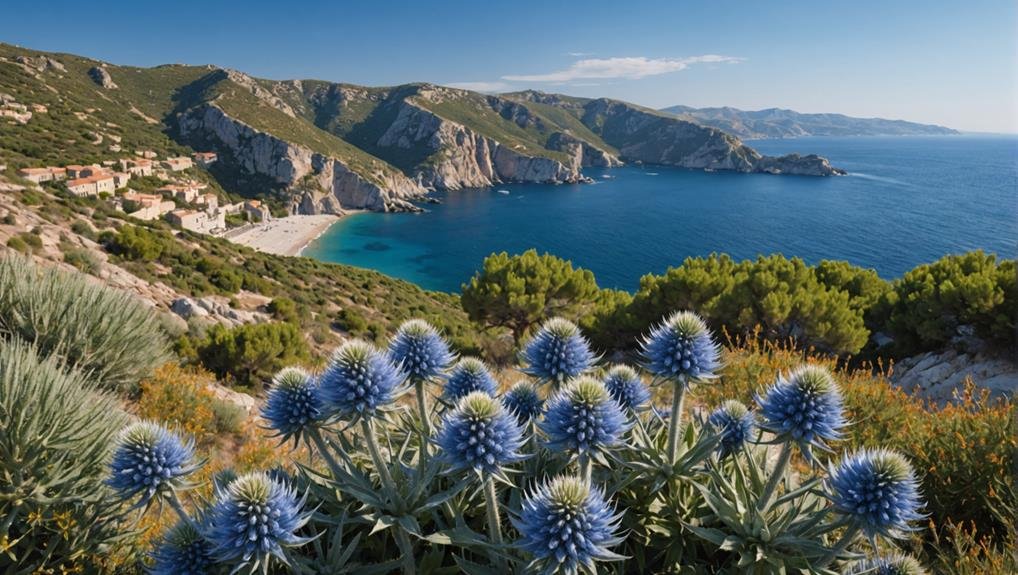
Eryngium, commonly known as Sea Holly, has its geographical origins in Europe, North Africa, and Asia. This plant thrives in diverse climates, which contributes to its widespread popularity in floral arrangements across the globe. Its ability to adapt to various environmental conditions makes it a versatile choice for a range of wedding themes and settings.
Sea Holly is not related to the holly plant despite its name, which often leads to some confusion. Instead, it falls under the Apiaceae family, known for its unique, spiky texture and striking blue or silver hues. These characteristics make Eryngium an excellent option for adding a touch of rustic elegance or a coastal vibe to floral designs.
The plant’s origins in regions with varying climates underscore its resilience and adaptability. Whether growing along the Mediterranean coasts or in the temperate zones of Europe and Asia, Sea Holly maintains its distinctive appearance, making it an ideal choice for wedding bouquets and centerpieces. Its geographic diversity also means that it can be sourced from multiple locations, ensuring availability for brides and event planners who seek its unique aesthetic for their special day.
Season Availability
Sea Holly’s season availability peaks during the summer and autumn months, making it an ideal choice for weddings and events held in these seasons. This period guarantees that these striking, spiky blue flowers are at their freshest and most vibrant, providing a unique aesthetic to floral arrangements. Given its seasonal nature, understanding the best times to source Sea Holly can assist in planning and securing the most beautiful blooms for your special day.
To enhance your understanding of Sea Holly’s availability, consider the following key points:
- Seasonal Peak: Sea Holly is most abundantly available from June to October, aligning perfectly with summer and autumn weddings.
- Domestic and Imported Sources: While Sea Holly is commercially grown in Australia, it is also imported, ensuring a steady supply despite seasonal fluctuations.
- Quality Considerations: Always look for fresh, well-formed bunches without blemishes to ensure the highest quality for your arrangements.
- Wholesale Purchasing: Sea Holly is typically sold in wraps of 10 to 25 stems at flower markets, making it convenient to purchase the quantity needed for your event.
Growing Conditions
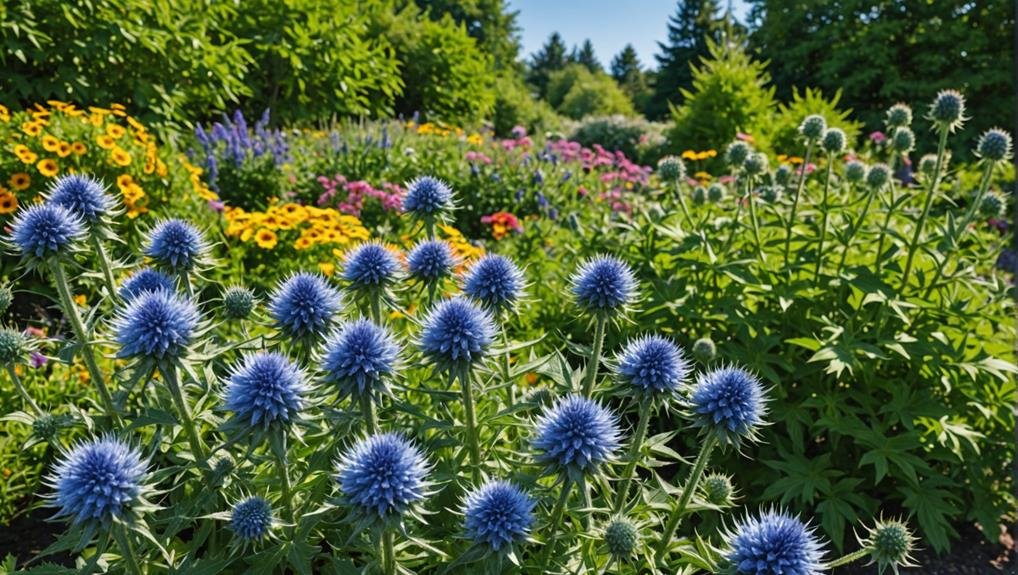
Understanding the growing conditions for Eryngium is essential to ensuring these stunning flowers thrive and reach their full potential in your garden or floral arrangements. Sea Holly requires full sun exposure, ideally receiving 6-8 hours of direct sunlight daily. This exposure is vital for robust growth and vibrant blooms. Additionally, Eryngium prefers well-draining soil and can adapt to various soil types, including sandy and loamy soil.
Sea Holly’s drought tolerance is a notable feature, making it an excellent choice for dry conditions once established. It is suitable for USDA hardiness zones 4-9, showcasing its adaptability to a range of climates. To achieve best growth and flower production, maintaining a soil pH level between 6.0 and 7.0 is recommended.
Below is a summary table of Eryngium’s growing conditions:
| Aspect | Details |
|---|---|
| Sun Exposure | Full sun (6-8 hours daily) |
| Soil Preference | Well-draining, sandy, loamy |
| Drought Tolerance | High, once established |
| USDA Zones | 4-9 |
| Ideal pH Level | 6.0 to 7.0 |
Cultural Significance
Celebrated for its resilience and enchanting appearance, Eryngium holds profound cultural significance across various traditions. This distinctive plant, often chosen as wedding flowers, is imbued with rich symbolism that makes it an intriguing addition to any celebration.
Below are four key aspects of Eryngium’s cultural significance:
- Symbol of Strength and Resilience: Eryngium is widely recognized as a symbol of strength and resilience. Its sturdy nature and ability to thrive in challenging conditions make it a powerful emblem for enduring love and commitment.
- Protection and Warding Off Negative Energy: In folklore, Sea Holly is believed to offer protection and ward off negative energy. This makes it a meaningful choice for wedding flowers, symbolizing a shield against life’s adversities as couples commence on their new journey together.
- Defense and Durability: The unique spiky texture of Eryngium has long been associated with defense and durability. Including it in wedding arrangements can convey a message of safeguarding the relationship and enduring through challenges.
- Tranquility, Loyalty, and Stability: The blue hue of Sea Holly is often linked to tranquility, loyalty, and stability. These qualities are highly valued in wedding traditions, representing calm and steadfast love.
These cultural connotations of Eryngium enrich its role in wedding celebrations, adding layers of meaning to its already captivating presence.
Typical Use in Weddings
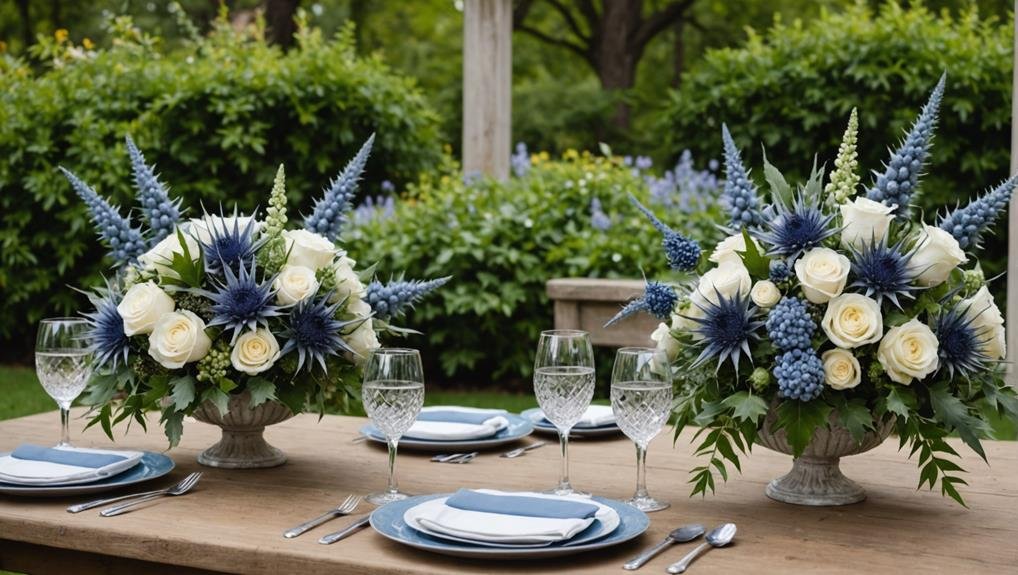
Eryngium is a popular selection in wedding floral arrangements for its distinctive texture and striking blue hue. Known commonly as Sea Holly, this plant’s thistle-shaped flowers and metallic silver appearance make it a standout element in various wedding designs. Its unique look is particularly favored in rustic, beach-themed, and whimsical weddings, where it adds a natural, yet eye-catching, touch to the overall aesthetic.
Sea Holly’s spiky texture brings depth and interest to bridal bouquets, elevating them from traditional to extraordinary. Beyond bouquets, Eryngium is also commonly used in boutonnieres, where its sturdy structure guarantees longevity throughout the day. Additionally, its versatile nature makes it an excellent choice for centerpieces and other floral decorations, where it pairs seamlessly with a variety of flowers and greenery.
The distinct characteristics of Sea Holly make it a valuable asset in creating stunning and memorable wedding flower displays. Its ability to complement a wide range of floral elements while adding its own unique flair ensures that it remains a sought-after choice for couples looking to infuse their wedding day with a touch of natural beauty and elegance.
Alternative Flower Types
As couples explore various floral options for their weddings, considering alternative flower types like Eryngium can offer an invigorating departure from traditional choices. Eryngium, or Sea Holly, with its thistle-shaped blooms and striking blue/silver hues, can add a distinctive touch to bridal bouquets and arrangements. Its unique texture and color make it particularly suitable for rustic or beach-themed weddings, providing a fresh and modern aesthetic.
To inspire your floral arrangements, here are four alternative flower types that can serve as a focal flower or complement Eryngium:
- Eucalyptus: Known for its aromatic leaves and versatile use, eucalyptus pairs beautifully with Eryngium, adding greenery and texture to bouquets.
- Thistles: These flowers share a similar structure with Eryngium, creating a cohesive yet varied look when combined, perfect for achieving a rustic charm.
- Succulents: With their unique shapes and subtle colors, succulents can enhance the modern, eclectic feel of an arrangement featuring Eryngium.
- Protea: For a bold statement, Protea’s large, exotic blooms can act as a focal flower, drawing attention while complementing the more subtle hues of Eryngium.
